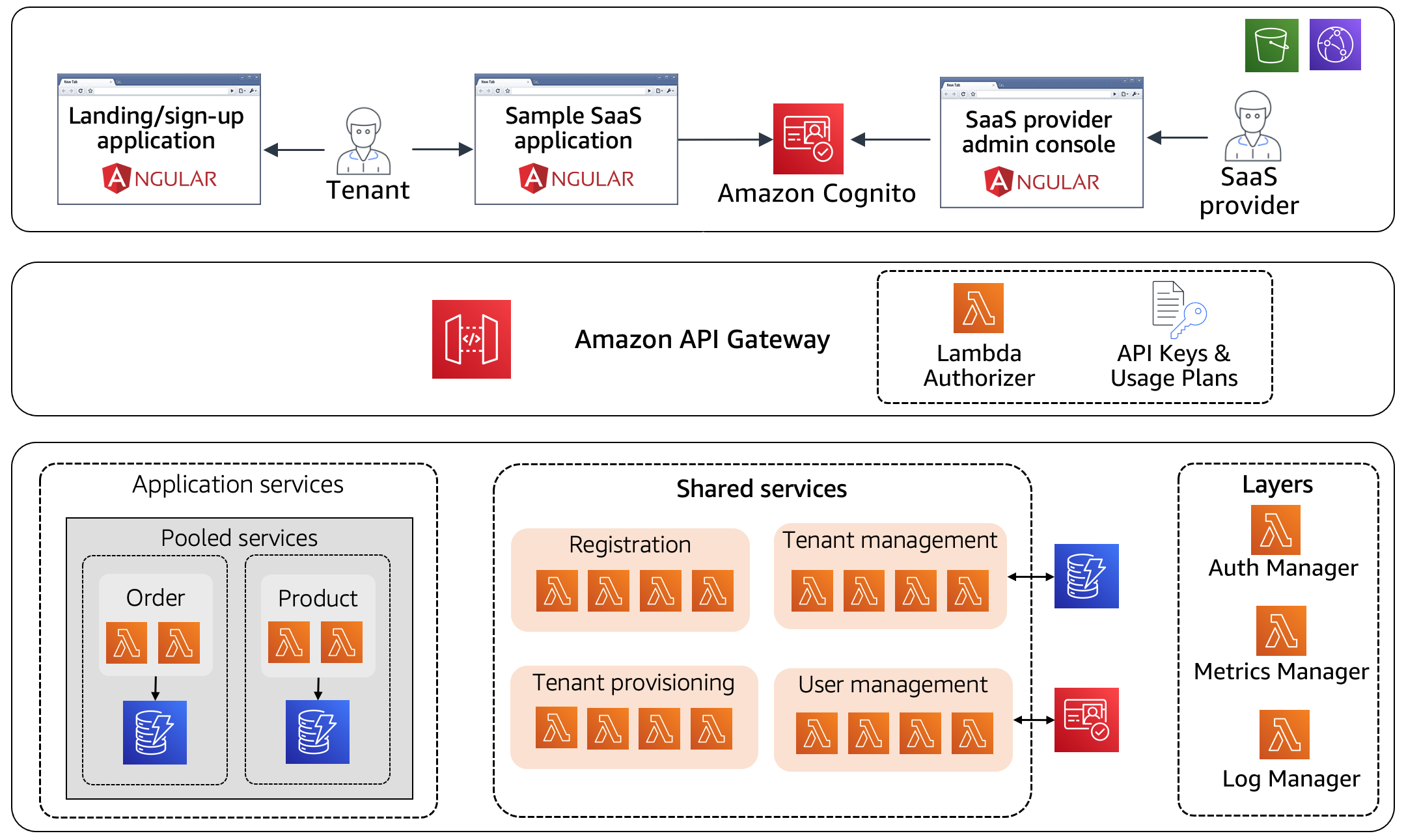Serverless SaaS - Reference Solution
Feedback & Feature request | Documentation
The move to a software-as-a-service (SaaS) delivery model is accompanied by a desire to maximize cost and operational efficiency. This can be especially challenging in a multi-tenant environment where the activity of tenants can be difficult to predict. Finding a mix of scaling strategies that align tenant activity with the actual consumption of resources can be elusive. The strategy that works today might not work tomorrow.
These attributes make SaaS a compelling fit for a serverless model. By removing the notion of servers from your SaaS architecture, organizations can rely on managed services to scale and deliver the precise number of resources your application consumes. This simplifies the architecture and operational footprint of your application, removing the need to continually chase and manage scaling policies. This also reduces the operational overhead and complexity, pushing more of operational responsibility to managed services.
The code in this repository is intended to provide a sample implementation of a SaaS solution using Serverless Technologies. The goal is to provide SaaS developers and architects with working code that illustrates how to design and deliver a multi-tenant SaaS on AWS. The solution covers a broad range of multi-tenant considerations, including onboarding & identity, tenant and user management, authentication & authorization, data partitioning, tenant isolation, automated deployment, and multi-tenant observability. It provides developers with a prescriptive approach around the fundamentals of building SaaS solution using Serverless Technologies, such as Amazon API Gateway, Amazon Cognito, AWS Lambda, Amazon DynamoDB and AWS CodePipeline. The focus here is more on giving developers a view into the working elements of the solution without going to the extent of making a full, production-ready solution. Instead, we're hoping this can jump start your process and address some of the common challenges that teams must address when delivering a Serverless SaaS solution.
Note that the instructions below are intended to give you step-by-step, how-to instructions for getting this solution up and running in your own AWS account. For a general description and overview of the solution, please see the developer's documentation here.
High Level Architecture
Figure 1 provides a high-level representation of the baseline architecture that will get deployed, once you complete the deployment. As mentioned before, please see the documentation to understand the architecture in more detail.
 Figure 1: Baseline infrastructure
Figure 1: Baseline infrastructure
Pre-requisites
- This reference architecture uses Python. Make sure you have Python 3.8 Installed.
- Make sure you have AWS CLI Installed.
- Make sure you have the latest version of AWS SAM installed. Not having the release version of SAM can cause deployment issues.
- Make sure you have the latest version of AWS CDK CLI installed. Not having the release version of CDK can cause deployment issues.
- Make sure you have the latest version of git-remote-codecommit installed.
- Make sure that you have Angular 11 or above
- Make sure that you have Node 12 or above.
- Ensure that CloudWatch log role ARN is set for the API Gateway. In order to do so, go to the API Gateway page, inside AWS Console, and click on any one of the REST APIs listed in the console (You might have to create an Example REST API if you don't have one created.). Click on Settings from the left navigation bar and provide an IAM role that have access to publish logs to CloudWatch. Refer this link if you need more details.

Figure 2: CloudWatch log role ARN
Setting up the environment
NOTE: If you are using Cloud9 to deploy the architecture, then make sure that to select at least t3.large instance size and increase the volume size of the underlying EC2 instance to 50 GB (instead of default 10 GB). This is to make sure that you have enough compute and space to build the solution.
Run the below script to deploy the required component. Replace the "test@test.com" email address with yours. This email address is used to setup an admin user in the architecture.
. deployment.sh test@test.com
This script will take few minutes to complete. Once complete it will deploy the following:
- Bootstrap CDK in your account
- Deploy Tenant Pipeline using CDK. This pipeline uses CodePipeline and is responsible for auto updating the stack for all the tenants in an automated fashion.
- Deploy the bootstrap stack, which initializes the environment by setting up Cognito, DynamoDB tables and Shared services (Tenant registration, tenant management and user management)
- Deploy the pooled tenant stack, using code pipeline, which deploys the multi-tenant order and product services.
- Deploy three web applications, namely "SaaS Provider Admin console", "Landing/sign-up application" and "Sample SaaS commerce application", using S3 and CloudFront. The script will output the URL for these three user interfaces, after it finishes.
Once the above script finishes successfully, go to the CodePipeline page, inside AWS Console, to make sure that the Pipeline has been deployed successfully. You might have to wait for few minutes before the Pipeline finishes.
Steps to Clean-up
Use the below steps to perform clean-up in your account:
- Delete the CloudFormation stack named "stack-pooled".
- Depending upon how many Platinum tier tenants you have provisioned, delete the tenant specific stacks. They will all be named as "stack-TENANTID", where TENANTID is a UUID.
- Delete the baseline stack named as "serverless-saas". Make sure the above two stacks are deleted before you try deleting this.
- Delete the Tenant Pipeline stack named as "serverless-saas-pipeline".
- Delete the CodeCommit repository created by the script. It should be named as "aws-saas-factory-ref-serverless-saas".
- Delete any left over S3 Buckets. They should start with a prefix "serverless-saas" and "sam-bootstrap-bucket".
License
This library is licensed under the MIT-0 License. See the LICENSE file.
Security
See CONTRIBUTING for more information.
